Kabola Winery
by
Terry Sullivan
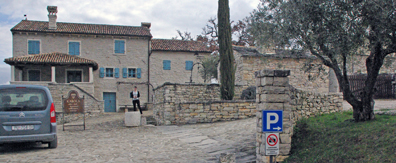 Summary: A sign on Kremenje Road marks the driveway to Kabola Winery. This winery located in Momjan grows indigenous grapes and crafts different wines with these grapes. Taking a process from the ancients, Kabola produces a Malvazija in buried amphorae where the wine ferments and ages for a number of months.
Summary: A sign on Kremenje Road marks the driveway to Kabola Winery. This winery located in Momjan grows indigenous grapes and crafts different wines with these grapes. Taking a process from the ancients, Kabola produces a Malvazija in buried amphorae where the wine ferments and ages for a number of months.
The driveway to the parking area has vineyards to the left. The winery is just feet from the parking area. We were met by Maja Vižintin who, because of a threat of rain, first took us to look at the vineyard. We stopped at a spot where six amphorae were covered with a blue tarp. The amphorae are large vessels buried under ground. Also known as kvevri these terra cotta pots are made from clay and the interior walls are lined with beeswax. There are only a few artisans in the world who know how to make kvevri. Only a handful of wineries in the world still use this process for making wine. The process of fermenting wine in kvevri underground was believed to have started in Georgia thousands of years ago.
Kabola Winery may use an ancient winemaking process, but it is a modern facility. In 2000 Marino Markežić bought the property and opened the winery in 2005. Kabola is his family nickname. The logo for the winery shows two connected letter m’s over six circles arranged to resemble a bunch of grapes as well as the shape of Istria. The original house dates from 1873. Prior to this winery Marino Markežić spent 30 years in the restaurant industry. During that time he made small quantities of wine. Marino is the family’s winemaker.
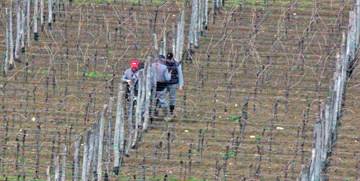 Vineyards
Vineyards
Maja pointed out the landscape of the area and attested that on clear days you can easily see the Adriatic Sea and across to Italy. We were able to see the Adriatic but there was too much of a haze to see beyond the coastline just a few kilometers away. The vineyards sloped down to the road and we saw four vineyard workers tending to a row of stakes. From our vantage point, there was a row of stakes followed by five rows of vines then another row of stakes and so on.
The 17 hectares (42 acres) of vineyards were planted with Malvazija Istarska, Muškat Momjanski, Teran, Cabernet Sauvignon, Merlot and Chardonnay. Although much of the soil in Istria is a red clay soil, in this vineyard most of the soil is a white clay. The soil gives the grapes mineral characteristics. Biodynamic principles are followed in the vineyards including spraying prepared teas on the vineyard and mulching.
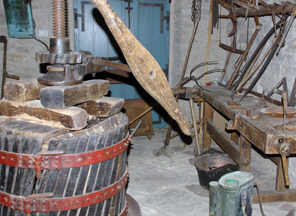
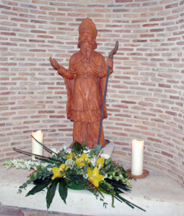 Winery
Winery
As we toured the winery we were on the look out for something different. One room was set up as a small museum consisting of many artifacts. Amongst the demijohns, there was an old wooden basket press and several vineyard tools. Along a stairway, there was a statue of St. Martin, a patron saint of vineyards and wine. The cellar had a mixture of barriques stacked two high and large capacity wood tanks.
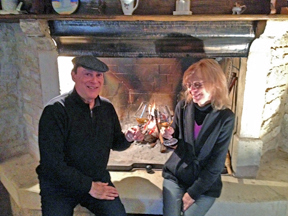 Tasting Rooms
Tasting Rooms
During our tour, Maja showed us several rooms where tastings and degustations can take place. Large groups can experience tasting in another building where two long rows of tables are set up in a charming room with a country home-style appearance. Tastings for a few individuals can be held at the small tasting counter in the retail area of the main building. By the time of our tastings, a steady rain was falling. We had the tasting in a cozy room near a fire, the perfect setting for tasting wine on a cool rainy day.
Wines
We tasted five wines with Maja. The 2011Malvazija Istarska had a yellow color. The wine had floral and citrus on the aroma. The taste offered honeysuckle, citrus and tropical fruits. The finish was crisp and fruity with the fruit yielding to some minerality. The 2009 Unica was a Malvazija Istarska that aged in the large oak tanks. It was a dark yellow color and had a floral aroma. Floral notes along with hints of caramel and vanilla were tasted and the finish was slightly crisp with minerals on the aftertaste.
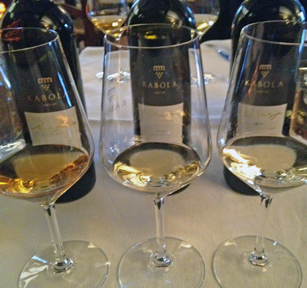 The 2007 Amfora was the wine we were anxious to try. An amphora wine is not made every vintage. The grapes have to have an outstanding growing season. There was a 2011 vintage, but no 2012 vintage. Grapes are added to the kvevri including the juice and skins. During the fermentation period of two to three weeks, the cap is punched down. Nitrogen is then added to reduce the risk of oxygenation. The wine is left to age on the skins for several months. It is then pressed and added to large oak barrels for another a year of aging. This wine, also made from Malvazija Istarska was a dark gold color. The aroma and taste had dried fruits especially figs and apricots. There was also a noted minerality to the taste. Dried fruit was also present on the crisp finish that too had a mineral aftertaste.
The 2007 Amfora was the wine we were anxious to try. An amphora wine is not made every vintage. The grapes have to have an outstanding growing season. There was a 2011 vintage, but no 2012 vintage. Grapes are added to the kvevri including the juice and skins. During the fermentation period of two to three weeks, the cap is punched down. Nitrogen is then added to reduce the risk of oxygenation. The wine is left to age on the skins for several months. It is then pressed and added to large oak barrels for another a year of aging. This wine, also made from Malvazija Istarska was a dark gold color. The aroma and taste had dried fruits especially figs and apricots. There was also a noted minerality to the taste. Dried fruit was also present on the crisp finish that too had a mineral aftertaste.
The 2009 Teran was a dark ruby color. Tobacco and dark fruits were noted on the aroma. The taste was reminiscent of plums, black raspberries and minerals. Tannins accompanied the fruity finish that changed to spices on the aftertaste.
The 2011 Muškat Momjanski was a yellow color. The aroma and taste was floral reminding me of peach skins, orange blossoms and honeysuckle. The finish was crisp with layers of fruit and flowers.
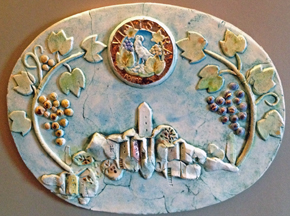 Wine enthusiasts who visit Kabola Winery can experience the meeting of ancient and modern. They can experience and taste the place. While there, view the several awards Kabola Winery has won for its wines. The awards are beautiful ceramic designs.
Wine enthusiasts who visit Kabola Winery can experience the meeting of ancient and modern. They can experience and taste the place. While there, view the several awards Kabola Winery has won for its wines. The awards are beautiful ceramic designs.
Kabola Winery
Kremenje 96b
52462 Momjan, Croatia
GPS: N45º 25.822’ E13º 42.023’
Article written March 2013
Visit these tour operators tha partner with Wine Trail Traveler.
SmoothRed London, England, United Kingdom |
